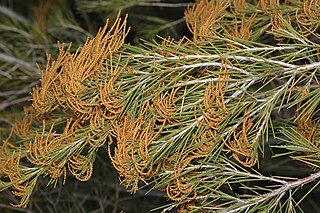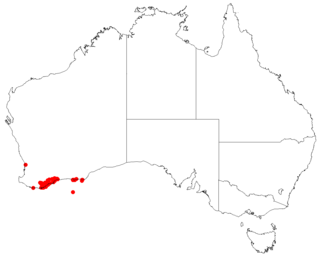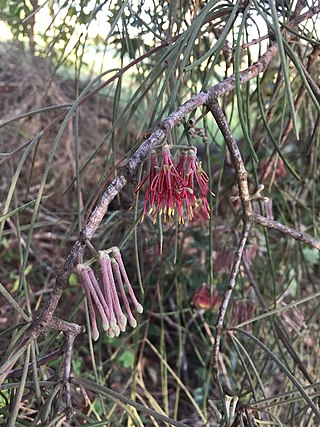
Allocasuarina, commonly known as sheoak or she-oak, is a genus of flowering plants in the family Casuarinaceae and is endemic to Australia. Plants in the genus Allocasuarina are trees or shrubs with soft, pendulous, green branchlets, the leaves reduced to scale-like teeth. Allocasuarinas are either monoecious or dioecious, the flowers never bisexual. Male and female flowers are arranged in spikes, the female spikes developing into cone-like structures enclosing winged seeds.

Casuarina is a genus of flowering plants in the family Casuarinaceae, and is native to Australia, the Indian subcontinent, Southeast Asia, islands of the western Pacific Ocean, and eastern Africa. Plants in the genus Casuarina are monoecious or dioecious trees with green, pendulous, photosynthetic branchlets, the leaves reduced to small scales arranged in whorls around the branchlets, the male and female flowers arranged in separate spikes, the fruit a cone containing grey or yellowish-brown winged seeds.

Allocasuarina torulosa, the rose she-oak or forest oak or rose them-oak or rose they-oak, is a tree which grows in sub-rainforest of Queensland and New South Wales, Australia. There, it is typically found on coastal footslopes, hills, and plains. Originally described as Casuarina torulosa by William Aiton, it was moved to its current genus in 1982 by Australian botanist Lawrie Johnson. It is the type species of the genus Allocasuarina.

Allocasuarina humilis, commonly known as the dwarf sheoak or dwarf casuarina, is a woody shrub of the family Casuarinaceae endemic to the south-west of Western Australia.

Allocasuarina distyla, commonly known as scrub she-oak, is a species of flowering plant in the family Casuarinaceae and is endemic to south-eastern New South Wales. It is a dioecious shrub that has branchlets up to 350 mm (14 in) long, the leaves reduced to scales in whorls of six to eight, the fruiting cones 13–35 mm (0.51–1.38 in) long containing winged seeds (samaras) 4.0–8.0 mm (0.16–0.31 in) long.

Kunzea ambigua, commonly known as white kunzea, poverty bush or tick bush, is a plant in the myrtle family, Myrtaceae and is found mainly on sandstone soils in eastern Australia. Growing up to 5 m (16 ft) high and wide, it bears small white flowers in spring. Used in native gardening, it attracts native insects. It is also used in amenities planting and sand dune stabilization.

Casuarina glauca, commonly known as swamp she-oak, swamp buloke, swamp she-oak, marsh sheoak, grey she-oak, grey she-oak or guman by the Gadigal people, is a species of flowering plant that is endemic to eastern Australia. It is a dioecious tree that often forms root suckers and has fissured and scaly bark, spreading or drooping branchlets, the leaves reduced to scales in whorls of 12 to 20, the fruit 9–18 mm (0.35–0.71 in) long containing winged seeds (samaras) 3.5–5.0 mm (0.14–0.20 in) long.

Glochidion ferdinandi, with common names that include cheese tree, is a species of small to medium–sized trees, constituting part of the plant family Phyllanthaceae. They grow naturally across eastern Australia, from south–eastern New South Wales northwards to northern and inland Queensland, in rainforests and humid eucalypt forests. Frugivorous birds such as pigeons, figbirds and parrots consume its fruit.

Angophora floribunda, commonly known as the rough-barked apple, is a common woodland and forest tree of the family Myrtaceae native to Eastern Australia. Reaching 30 m (100 ft) high, it is a large tree with fibrous bark and cream-white flowers that appear over the Austral summer. It grows on alluvial soils on floodplains and along watercourses. Much of the land it grew on has been cleared for agriculture.

Lomatia silaifolia, commonly known as crinkle bush or parsley fern, is a plant of the family, Proteaceae native to eastern Australia. Naturally found in open forest, it grows as a small shrub 1–2 m high with highly pinnate leaves reminiscent of parsley. The white inflorescences appear in summer.

Amyema congener, commonly known as the variable mistletoe, is a species of flowering plant, an epiphytic hemiparasitic plant of the family Loranthaceae from eastern Australia. It is found on members of the genera Allocasuarina, Acacia and some exotic species.

Allocasuarina paludosa, commonly known as the swamp sheoak or scrub sheoak, is a woody shrub of the family Casuarinaceae. It is endemic to south-eastern Australia.

Allocasuarina decussata, commonly known as karri oak or karri she-oak, is a medium-sized tree, or more rarely a shrub, that is endemic to the south west of Western Australia. It is an understory tree in karri forest but also occurs as a stunted shrub in places like Bluff Knoll in the Stirling Range.
Micromyrtus grandis, the Severn River heath-myrtle, is a shrub in the myrtle family. It is found exclusively in the Severn River Nature Preserve and a property next to it, located around 60 km north-west of Glen Innes (Australia). It grows up to 1–4 metres tall, making it the largest plant in the genus Micromyrtus. The Severn River heath-myrtle is characterized by its fruit, which is 5-ribbed, and its broader leaves when compared to other nearby flora.

Allocasuarina acuaria is a species of flowering plant in the family Casuarinaceae and is endemic to the southwest of Western Australia. It is a dioecious shrub that has erect branchlets, the leaves reduced to scales in whorls of four on the ends of the branchlets, the fruiting cones 15–19 mm (0.59–0.75 in) long containing winged seeds (samaras) about 6 mm (0.24 in) long.

Allocasuarina acutivalvis is a species of flowering plant in the family Casuarinaceae and is endemic to the southwest of Western Australia. It is a dioecious shrub to small tree that has erect branchlets, the leaves reduced to scales in whorls of 10 to 14, the fruiting cones 15–35 mm (0.59–1.38 in) long containing winged seeds (samaras) 6–12 mm (0.24–0.47 in) long.

Allocasuarina thuyoides, commonly known as the horned sheoak, is a shrub of the genus Allocasuarina native to a large area in the Mid West, Wheatbelt, South West and Goldfields-Esperance regions of Western Australia.

Allocasuarina trichodon is a shrub of the genus Allocasuarina native to an area along the south coast in the Great Southern and Goldfields-Esperance regions of Western Australia.

Allocasuarina striata, commonly known as the small bull oak, stalked oak-bush or the tall oak-bush, is a shrub of the genus Allocasuarina native to South Australia.

Amyema cambagei, commonly known as sheoak mistletoe, is a species of flowering plant, an epiphytic hemiparasitic plant of the family Loranthaceae endemic to Australia, and found in New South Wales and Queensland in sclerophyll forest and woodland on several species of Casuarinaceae.




















